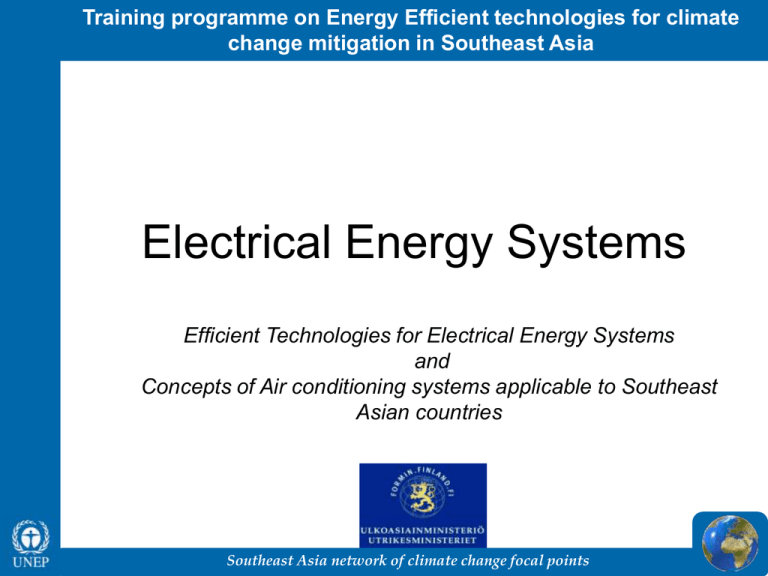Electrical Energy Systems
advertisement

Training programme on Energy Efficient technologies for climate change mitigation in Southeast Asia Electrical Energy Systems Efficient Technologies for Electrical Energy Systems and Concepts of Air conditioning systems applicable to Southeast Asian countries Southeast Asia network of climate change focal points Electrical Power supply system Southeast Asia network of climate change focal points Efficiency in transmission and distribution system Generation Efficiency 1 Step-up Station 2 EHV Transmission & 3 Station Efficiency ranges 28-38 % with respect to size of thermal plant, age of plant and capacity utilization Step-up to 400 / 800 kV to enable EHV transmission. Envisaged max. losses 0.5 % or efficiency of 99.5 % EHV transmission and substations at 400 kV / 800 kV. Envisaged maximum losses 1.0 % or efficiency of 99 % HV Transmission & Station 4 HV transmission & Substations for 220 / 400 kV. Envisaged maximum losses 2.5 % or efficiency of 97.5 % Sub-transmission 5 Sub-transmission at 66 / 132 kV Envisaged maximum losses 4 % or efficiency of 96 % Distribution Station 6 Step-down to a level of 11 / 33 kV. Envisaged losses 0.5 % or efficiency of 99.5 % Primary Distribution 7 Distribution is final link to end user at 11 / 33 kV. Envisaged losses maximum 5 % of efficiency of 95 % End user Premises Cascade efficiency from Generation to end user = 1 2 3 4 5 6 7 The cascade efficiency in the T&D system from output of the power plant to the end use is 87% (i.e. 0.995 x 0.99 x 0.975 x 0.96 x 0.99.5 x 0.95 = 87%) Southeast Asia network of climate change focal points Electricity Billing The consumer depending on type (i.e. industrial, commercial, residential, utilities etc.) pays for: - Energy Charges for kWh consumed - PF penalty or PF incentives - Maximum demand Charges (kVA) registered – Time of Day (TOD), (peak and non-peak ) – Maximum Demand Penalty – Metering rent – Other Penalties etc. Southeast Asia network of climate change focal points Power Factor (PF) In most modern electrical distribution systems, the predominant loads are resistive and inductive. 1) Resistive loads are incandescent lighting and resistance heating. 2) Inductive loads are A.C. Motors, induction furnaces, transformers and ballast-type lighting Inductive loads require two kinds of power: 1) Active (or working) power to perform the work (motion) and 2) Reactive power to create and maintain electro-magnetic fields. 3) The vector sum of the active power and reactive power make up the total (or apparent) power used. This is the power generated by the utility for the user to perform a given amount of work. Southeast Asia network of climate change focal points Capacitors and Effect on PF Example : In an industry there is a transformer installed with a rating of 1500 KVA Transformer loading – 1160/1500 = 78 % Capacitors totaling 410 kVAr installed Transformer loading – 913/1500 = 61 % Southeast Asia network of climate change focal points Rating of capacitors required • The utility bill shows an average power factor of 0.72 with an average KW of 627. How much KVAR is required to improve the power factor to .95 ? • STEPS: Cos F1 = 0.72 , Tan F1 = 0.963 Cos F2 = 0.95 , Tan F2 = 0.329 Kvar required = P ( Tanf1 - Tanf2 ) = 627 (0.964 – 0.329) = 398 kVAr • Now that we have determined that capacitors totaling 400 KVAR must be installed, we must decide where to locate them • For motors of 50 hp and above, it is best to install power factor correction capacitors at the motor terminals since distribution circuit loading is reduced • Capacitor banks can also be connected at the bus bar for each motor control centre. This is a compromise to reduce installation costs Southeast Asia network of climate change focal points Advantages of PF correction • Capacitors can reduce losses by 1- 2% of the total load % Loss Reduction = 1 - PF1 / PF2 2 x 100 • Reduction in maximum demand We know that kW = kVA x Cos F If the maximum demand is 1500 kVA at 0.85 p.f. calculate the reduction in demand at 0.95 p.f. Active Power = 1500 x 0.85 = 1275 kW Maximum demand after PF improvement, kVA at 0.95 p.f. = 1275/0.95 = 1342 kVA Southeast Asia network of climate change focal points Technology : Automatic PF controllers Southeast Asia network of climate change focal points Maximum Demand (MD) •The demand varies from time to time. The demand is measured over predetermined time interval and averaged out for that interval as shown by the horizontal dotted line. •It is important to note that while maximum demand is recorded, it is not the instantaneous demand drawn, as is often misunderstood, but the time integrated demand over the predefined recording cycle Southeast Asia network of climate change focal points Example of Computing MD – As example, in an industry, if the drawl of power over a recording cycle of 30 minutes is : – 2500 kVA for 4 minutes – 3600 kVA for 12 minutes – 4100 kVA for 6 minutes – 3800 kVA for 8 minutes – The MD recorder will be computing MD as: – (2500x4) +(3600 x 12) + (4100 x 6) + (3800 x 8) kVA 30 Southeast Asia network of climate change focal points = 3606.7 Load Management Strategies • Reschedule loads/Staggering of motor loads • Storage of products/in process material/process utilities like refrigeration • Shedding of non essential loads • Operation of Captive power generation • Reactive power compensation Southeast Asia network of climate change focal points Technology : MD controller Southeast Asia network of climate change focal points Harmonics • In AC network, flow of current depends upon the voltage applied and the impedance (resistance to AC) provided by elements like resistances, reactances of inductive and capacitive nature. As the value of impedance in above devices is constant, they are called linear whereby the voltage and current relation is of linear nature. • However in real life situation, various devices like diodes, silicon controlled rectifiers, thyristors, voltage & current reducing electronic devices, induction & arc furnaces etc. are also deployed for various requirements and due to their varying impedance characteristic, these NON LINEAR devices cause distortion in voltage and current waveforms which is of increasing concern • Devices that draw non-sinusoidal currents when a sinusoidal voltage is applied create harmonics. Frequently these are devices that convert AC to DC. Some of these devices are listed below: – – – – – Electronic Switching Power Converters Computers, Uninterruptible power supplies (UPS), Solid-state rectifiers Electronic process control equipment, PLC’s, etc Electronic lighting ballasts, including light dimmer Reduced voltage motor controllers Southeast Asia network of climate change focal points Problems due to Harmonics • • • • • • • Blinking of Incandescent Lights Capacitor Failure Conductor Failure Flickering of Fluorescent Lights Fuses Blowing Motor Failures (overheating) Transformer Failures Southeast Asia network of climate change focal points Technology : Harmonic Filters • Tuned Harmonic filters consisting of a capacitor bank and reactor in series are designed and adopted for suppressing harmonics, by providing low impedance path for harmonic component. The Harmonic filters connected suitably near the equipment generating harmonics help to reduce THD to acceptable limits. • Benefits of Harmonic Filters Improve power factor ratings through harmonic recombination Isolate harmonic currents Minimize equipment problems through THD cancellation Reduce wasted energy Minimize current carried in plant cables Southeast Asia network of climate change focal points Technology : Soft Starter Southeast Asia network of climate change focal points Concepts of AC and chilling systems • What is a Ton of refrigeration (TR) ? • The cooling effect produced is quantified as tons of refrigeration. 1 ton of refrigeration is equal to 3024 kCal/hr heat rejected • The plant capacities upto 50 TR are usually considered as small capacity, 50 – 250 TR as medium capacity and over 250 TR as large capacity units. –Vapor Compression Systems –Vapor Absorption Systems Southeast Asia network of climate change focal points Options for AC and refrigeration systems • Air Conditioning – – – – Air Conditioning (for comfort / machine) Split air conditioners Fan coil units in a larger system Air handling units in a larger system • Refrigeration – Small capacity modular units of direct expansion type similar to domestic refrigerators, small capacity refrigeration units. – Centralized chilled water plants with chilled water as a secondary coolant for temperature range over 50C typically. Can also be used for ice bank formation. – Brine plants, which use brines as lower temperature, secondary coolant, for typically sub zero temperature applications, which come as modular unit capacities as well as large centralized plant capacities. Southeast Asia network of climate change focal points Cycle of vapor Compression System Southeast Asia network of climate change focal points Cycle of vapor Compression System Southeast Asia network of climate change focal points Vapor Absorption System • The absorption chiller is a machine, which produces chilled water by using heat such as steam, hot water, gas, oil etc. • Chilled water is produced by the principle that liquid (refrigerant), which evaporates at low temperature, absorbs heat from surrounding when it evaporates. • Pure water is used as refrigerant and lithium bromide solution is used as absorbent • Heat for the vapour absorption refrigeration system can be provided by waste heat extracted from process, diesel generator sets etc. Absorption systems require electricity to run pumps only. • Depending on the temperature required and the power cost, it may even by economical to generate heat / steam to operate the absorption system Southeast Asia network of climate change focal points How does VAR system work 1. Boiling point of the water is a function of pressure. At atmospheric pressure water boils at 100 deg. C. When maintained at high vacuum, water will boil and subcool itself. The boiling point of the water at 6 mm Hg (abs) is 3.7 deg. C. Southeast Asia network of climate change focal points How does VAR system work 2. Lithium Bromide (LiBr) has the property to absorb water due to its chemical affinity. At higher concentration and lower temperature LiBr absorbs water vapour (refrigerant vapour) very effectively Southeast Asia network of climate change focal points How does VAR system work 3. As Lithium Bromide becomes dilute it loses its capacity to absorb water vapour. It thus needs to be re-concentrated using a heat source. Heat source may be Steam or Flue gases or even Hot water. Southeast Asia network of climate change focal points How does VAR system work Southeast Asia network of climate change focal points Advantages of VAR system • Li-Br-water absorption refrigeration systems have a Coefficient of Performance (COP) in the range of 0.65 0.70 and can provide chilled water at 6.7 oC with a cooling water temperature of 30 oC. • Systems capable of providing chilled water at 3 oC are also available. Ammonia based systems operate at above atmospheric pressures and are capable of low temperature operation (below 0oC). • Absorption machines of capacities in the range of 101500 tons are available. • Although the initial cost of absorption system is higher than compression system, operational cost is much lower-if waste heat is used Southeast Asia network of climate change focal points Case Study : VAR - Trigeneration Simultaneous production of heat, electricity and chilled water Southeast Asia network of climate change focal points Tri-generation - Process Southeast Asia network of climate change focal points Components of Tri-generation Southeast Asia network of climate change focal points Vapor Absorption Refrigeration Southeast Asia network of climate change focal points System Configuration Southeast Asia network of climate change focal points For further inquiries Contact Rajiv.garg@unep.org Southeast Asia network of climate change focal points

